FAMILY ARANEIDAE - Orb Web Spiders
This page contains pictures and information about Orb Web Spiders (Family Araneidae, formerly Argiopidae) that we found in the Brisbane area, Queensland, Australia.

- Orb Web
Araneidae is a large family. They can be small to large in side. All species in this family, if they make webs, they make vertical or horizontal orb webs. Some species construct some sort of stabilizer in the center of the web. Some members in this family do not make web at all. All of them have eight eyes.
Their body and legs are usually hairy. It is believed that those hair are their major sensors, as the eyes to human, to sense the world. They extend their sense of touch by using their web as wall. The spider reacts to loud noise, so do not speak loudly when watching spider. The spider on its web will ignore the strong wind but will react to your slight blow towards it. Most web weaver spiders are blind, or at least with very poor eye sight. They will not react to the light of torch, or even the flash of camera. But they can distinguish day and night. We seldom see spiders build their webs during day time. More facts on spiders can be find in this page.
Most of us have the experience of walk into a big sticky spiders web. Suddenly covered by the sticky silk, we would be quite certain that the spider is now crawling on our body and we will immediately trying to jump and brush ourselves to get rid of the potentially harmful spider. However, the poor spider at this time should be more frighten than you, and most likely it has either dropped onto the ground or rushed up to a near by retreat.
Followings listed the Orb Web Spiders that we found.
Subfamily Araneinae
- Garden Orb-weaver


- Eriophora transmarina, TRIBE Cyclosini, leg to leg 50mm
- This spider also called Wheelweaving Spider or Orbweaving Spider. This is the most common spider in our area. We can easily find them from 5mm size to 50mm size in our garden. We have recorded how they build their webs and how they capture their prey on another pages. Garden Orb-weavers have their abdominal pattern highly variable. To see the different pattern that we collected, click here.
- Small Green Orb Weaver


- ? Eriophora praesignis, male, TRIBE Cyclosini, leg to leg 20mm


- Pictures taken in Yugarapul Park on Nov 2007. The spider was hiding on its silky retreat on leaf.
- Reference :
- 1. Eriophora praesignis - The Find-a-spider Guide for Australian Spiders, University of Southern Queensland, 2007.
- Small Black Orb Weaver


- Eriophora sp., TRIBE Cyclosini, body length 6mm
- Pictures were taken on Nov 2007 near Bulimba Creek in Sunnybank. The small spider was hiding on leaf. It is metallic black in colour with grey-silver dots.
- Reference:
- 1. Eriophora species - The Find-a-spider Guide for Australian Spiders, University of Southern Queensland, 2007.
- Sliver Lobed Spider


- Cyclosa sp., TRIBE Cyclosini, body length 8mm
- We saw this spider once in Karawatha Forest during late winter. Please also check this page.
- Brown Lobed Spider


- Cyclosa insulana or Cyclosa trilobata, TRIBE Cyclosini, body length 8mm
- This is a relatively small web build spider. The spider is brown in colour with patterned abdomen. Please click on here for more pictures and information.
- Scorpion-tailed Spider
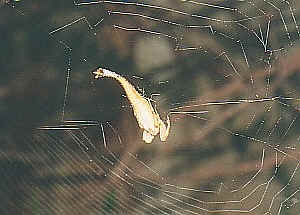
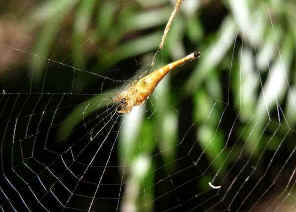
- Arachnura higginsi (A. higginsii), TRIBE Arachnurini, body length 20mm
- We some time find this Scorpion-tailed Spider in our back yard. It is golden yellow in colour. Its abdomen is long and slender, like a scorpion. Like most other members in this family, it build circuit web. It stay at the middle of the web in day and night. More information click this page.
- Leaf Nesting Spider
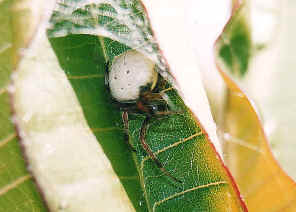

- Araneus albidus, leg Araneini, to leg 25mm
- We found this spiders once in our backyard during late summer. It curled a large green leaf as retreat. In day time its hided in the retreat. It rested at the middle of the web at night. There is a thread from the centre of its web linked to its retreat. So even when it hided in its retreat, it sensed by the link thread if there was prey get caught in it web. More pictures and information please click here.
- Bush Orb Weaver


- Araneus eburnus, TRIBE Cyclosini, body length 8mm
- This spider builds vertical orb web with one single stabilimentum. There are many of them on the hill top of Toohey Forest. They remain on their medium size vertical orb web during day and night. Please visit this page for more details.
- Wrap-around Spider


- Dolophones conifera, TRIBE Dolophonini, body length 15mm
- When this spider rests on a brown twig as it normally does, it is very hard to be noticed. This afternoon it (1st picture) made a mistake to rest on a green leaf so we easily found it. The Warp-around spiders are so called because of their concave abdomen curved in such a way that when the spider rests on a twig, it fits well and wrap around the twig. The spiders are brown in colour and rest during the day. They build large vertical orb web at night. More information and pictures can be found in this page.
- Tree-stump Spider


- Poltys illepidus, TRIBE Poltyini, body length 15mm
- This is a large web weaving spider with round button shape abdomen which overhangs and covers the head and throax. The surface of the abdomen has the very rough texture, brown in colour. This spiders build large vertical orb web at night. They pack-up and consume the web after used, hide on the tree during the day. Please also check this page.
- Triangular Spider
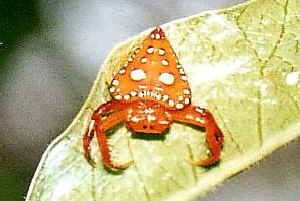

- Arkys lancearius, female, male, body length 10mm
- This is a beautiful spider. We can easily find them in bush land in Brisbane, although we never saw it in our backyard. Its abdomen is triangular to heart-shaped , with white spots on its bright orange body. Its two pairs of front legs are with strong spines for catching prey. Its two hind pairs legs are very small. Although they are in this family, which is famous in web building, they do not build webs. We have more information and pictures in this page.
- Triangular Spider II


- Arkys cornutus, leg to leg 15mm
- This is a beautiful spider. Its abdomen is triangular to heart-shaped , with white spots on its bright orange body. Its two pairs of front legs are with strong spines for capturing prey. Its two hind pairs legs are relatively small. It looks similar to the above species.
- Tent Spider


- Cyrtophora moluccensis, leg to leg 50mm
- Tent Spiders are very common in Brisbane garden. They have silver patterns on the body, some with yellow background colour, some are red and some are blue. They build tent shaped webs between plants and bushes. Their tent shaped webs are easily recognized, up to 60cm in diameter. The spider sit upside down in the middle of the tent from day to night. Sometimes we can see a few of the Tent Spiders build their tent webs joined together and cover an area of a few meters. For more pictures and information please click here.
- Russian Tent Spider
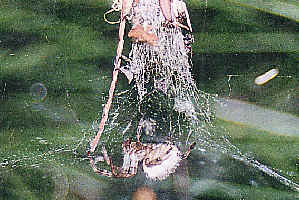

- Cyrtophora parnasia, leg to leg 12mm
- The Russian Tent Spider is rarely seen compared with Tent Spider. It builds a peaked web like a Russian tent and the tent is about 25cm in size. The spider has a white abdomen, brown head and brown legs. We recorded how Russian Tent Spider builds its tent shaped web on another page. In day time the spider hides inside the middle of the tent, where there is also the eggs sac, which is covered with messy silk and plant materials. Above and below the tent are messy tangles of threads.
- Pan-web Spider


- Cyrtophora exanthematica, leg to leg 15mm
- The Pan-web Spider is pale brown to dark grey in colour. We easily found this spider in Brisbane Botanic Garden. The spider builds web similar to Tent Spiders but with different shape. Instead of tent-shaped web, this Spider's webs are in pan shape. So we call them Pan-web Spiders. More information and pictures please click here.
- St Andrew's Cross Spider

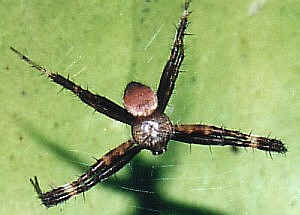
- Argiope keyserlingi, leg to leg female 50mm, male 20mm
- St Andrew's cross spider is common in Brisbane. It is easily recognized by the pattern on its body and its web. The spider makes an orb web, in the middle it makes four thickened zigzag strips in the shape of a cross of 'X'. This is why it called St Andrew's cross spider. The spider then hangs head down with its legs pairs together over the cross. More information can be found in the St Andrew's Cross Spider page.
- Banded Orb-weaving Spider


- Argiope trifasciata, leg to leg female 50mm, male 10mm
- Banded Orb-weaving Spiders sometimes may be confused with St Andrew's Cross Spiders. They look similar although the pattern on their abdomen are quite different. Banded Orb-weaving Spider females have yellow, white and brown colours bands across their abdomen. However, their males are look the same, much smaller than the female. More information and pictures please click here.
- Gumtree Trunk Weaver


- Argiope sp., female body length 10mm
- This spider build orb web against gumtree trunk. When we came close, they vibrate the web very quickly and they become almost invisible. The spiders are dark grey to black in colour, with white line along the sides of the long hreat-shaped abdomen. Legs are all black with white ring. We have more information and pictures in this page.
Subfamily Arkyinae
Subfamily Cyrtophorinae
Subfamily Argiopinae
Subfamily Cyrtarachninae
- Two-spined Spider
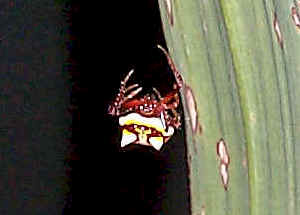

- Poecilopachys australasia, body size 8mm
- Two-spined Spiders build orb webs at night but hide under leaves during day time. They are not easy to find. Their body is brown with a yellow stripe. There is two white spines at the back look like eyes. This spider state in our garden for the whole summer.
Subfamily Mastophorinae
- Bird-dropping Spider


- Celaenia excavata (C. kinbergii ), body length 15mm
- You may think this is a bird-dropping, actually it is a spider. It sits motionlessly on the leaf on day time and active at night. It catch moths that fly to them. It is believe that they give off a sent which attracts a particular species of male moths. They are dirty white, grey and black in colour. We have details discussions on this spider..
- Jewel Spider, Spiny Spider


- Austracantha minax (was Gasteracantha minax), Body length 12mm
- Jewel Spiders are also known as Six Spined Spider, Christmas Spiders and Spiny Spiders. They can be found during summer, around Christmas time in Brisbane. Their abdomen has bright yellow and white patterns on black back ground. They build vertical orb web about one meter about ground and one meter in diameter. More information and pictures please click here.
- Please advise if you can identify any of them. Thank you.
- Spider species 1 not identified yet.

- ?sp., body length 6mm
- We only find this spider once in our backyard. The spider is white to transparent in colour, with two bright white spots on brown pattern on abdomen. Its legs are relatively small. The spider build orb web so we put it in this family. Its web is about 30cm in diameter, 45 degree to horizontal.
- Reference:
- 1. A Guide to Australian Spiders - Densey Clyne, Melbourne, Nelson 1969, p64.
- 2. FAMILY Araneidae Simon, 1895 - Department of Entomology, Texas A&M University,
[ Up ] [ Spider Scientific Facts ] [ How spider builds its web ? ] [ Orb web spiders ] [ Nephilid Spiders ] [ Stick spiders ] [ House Spiders ] [ Daddy Long-leg Spiders ] [ Comb-Footed Spiders ] [ Net-casting Spiders ] [ Uloborid spiders ] [ Unknown Spiders ] - 1. A Guide to Australian Spiders - Densey Clyne, Melbourne, Nelson 1969, p64.
